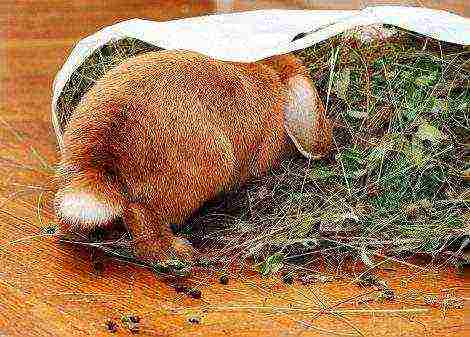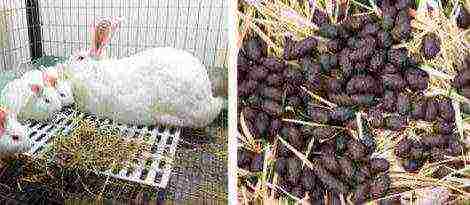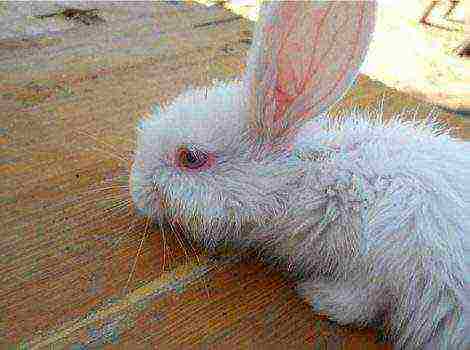Content
- 1 Rabbit farming as a business: benefits, profitability and income
- 1.1 Rabbit farming as a profitable business: advantages and disadvantages
- 1.2 Organizational and legal aspects
- 1.3 Form of taxation
- 1.4 How to start breeding animals from scratch?
- 1.5 Best breeds for breeding
- 1.6 Arrangement of the place of detention
- 1.7 Farm organization
- 1.8 How to organize feeding on the farm?
- 1.9 Breeding rabbits
- 1.10 Saving feed
- 1.11 Rabbit conditions and vaccination
- 1.12 Realization of domestic rabbit meat
- 1.13 Business profitability with a business plan
Rabbit farming as a business: benefits, profitability and income
Many people living in rural areas are engaged in rabbit breeding. Mostly to provide their family with fresh, tasty meat. In addition, rabbit meat is dietary and is indicated for use in many diseases, as well as for baby food. Rabbit breeding as a business is not very widespread.
But this is the only business that can be started with minimal costs. Animal fertility, the high cost of meat and low competition are important components of a consistent, high income from this type of activity. With a skillful approach and organization, this business can become exactly what will bring you a stable and high income.
In this article, we'll take a look at rabbit farming as a business, where to start and how to succeed.
Rabbit farming as a profitable business: advantages and disadvantages
Any entrepreneurial activity has its pros and cons. Rabbit breeding is no exception. The advantages of a mini farm include:
- Low financial costs for starting a business.
- High fertility, which does not require the purchase of young animals.
- A minimum of documents for the organization.
- Low maintenance costs.
- The high cost of meat.
- Broad sales opportunity.
- Low competition.
- Additional income from the sale of skins and manure.
Flaws:
- The disadvantage in rabbit breeding is the susceptibility to infectious diseases and, at the same time, high mortality.
- Strict sanitary requirements for care and breeding.
- Registration of relevant documents.

Organizational and legal aspects
What is better to arrange - a personal subsidiary farm, individual entrepreneurship or a farm?
Any kind of activity must be formalized and taxes must be paid. It is clear that if there are 20-30 rabbits on the farm, then this is not needed for personal consumption and registration. The choice of form depends on the number of animals and how many employees are on the farm. Let's take a closer look at the registration forms:
- Private household plots (personal subsidiary plots).
- SP (individual entrepreneurship).
- KFH (peasant farm).
LPH
Ideal for a novice businessman. Starting with a personal economy on your land, you have many opportunities for development. NSWhen conducting this form of production, taxes are not paid, but for conducting economic activities, you must provide a certificate of the availability of a land plot. Selling meat through the markets and to your friends.
What does the IP registration give?
With this form, it will be possible to open your own retail outlet for the sale of meat. And also supply them to other retail outlets. The entrepreneur is obliged to pay tax.On this issue, you should contact your local tax office for clarification, because the legislation in this matter is constantly changing.
Including you will need:
- Farm certificate.
- Receive a GOST-R declaration.
- Issue a phytosanitary certificate.
If there is no accounting knowledge, then you will need to hire a specialist to keep records. Therefore, it is better to register entrepreneurship with large volumes of production.
Peasant farm
Carries out any kind of agricultural activity. It is similar to entrepreneurship, except for some points:
- may have several farm managers with equal rights;
- no statutory and constituent document is required.
Be prepared to solve problems yourself.
Hence the conclusion, if you do not have production on an industrial scale, then at first it is better to dwell on the design of private household plots.
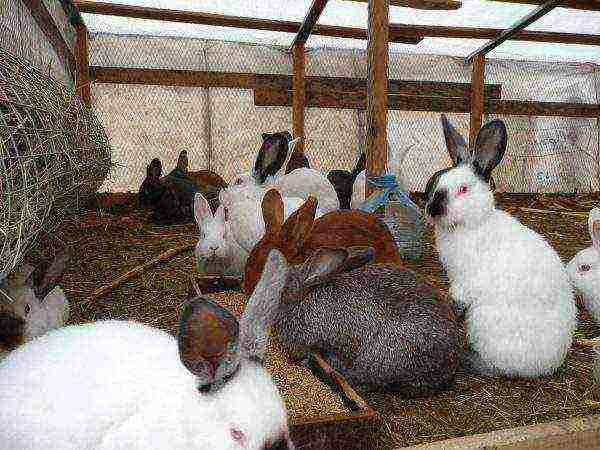
Form of taxation
There are two forms of taxation for the agricultural sector. This is a Simplified view, where income minus expenses and Common Agricultural. Which one is more convenient for you, you can ask for advice from a person engaged in accounting. Because it depends on the form of activity, on the number of employees and on the volume of production.
When registering, you will be assigned an OKVED code with coding - А.01.25.2. This means: breeding rabbits and fur animals on a farm. This code does not include meat and skins of animals obtained by hunting or trapping.
How to start breeding animals from scratch?
Any business starts with learning theory. Learn everything related to breeding rabbits: breeding, housing conditions, feeding, diseases and much more. Ask experienced breeders for advice. Study the instructions for drugs, such as Solicox.
Think about which cages the animals will be kept in. What kind of fodder they can get. On which land plot the complex will be located. Also read about all breeds of rabbits and think about which one will be more convenient for you to work with. Study the sales market.
Best breeds for breeding
It is best to choose breeds for breeding that can withstand our Russian climate and are not particularly demanding on keeping conditions. In this case, engaging in rabbit breeding will be beneficial.
Rabbit breeds for breeding are divided into:
- meat;
- meat and skin;
- downy.
There are also decorative rabbits, but they are kept as pets.
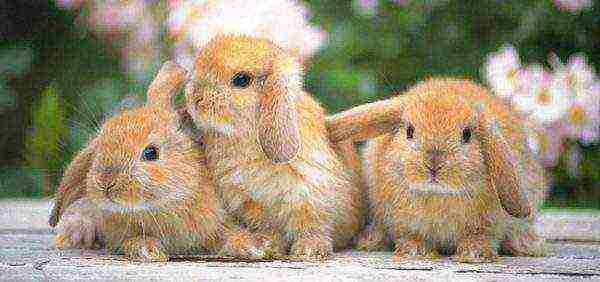
- Meat breed.
Fast growing rabbits. They gain maximum weight by six months. With sufficient care by 4 months, the carcass can be from 2 to 3 kg.
- The meat is skinny.
Rabbits from which you can get both skin and meat.
- Downy.
Rabbits with beautiful soft fluff, which many people use to make clothes.
Flanders
They belong to the meat breed. These rabbits are the largest. The body length reaches 70 cm. The weight of an adult individual reaches 10 kg. For breeding other large meat breeds, it was flanders that were used.
Rabbits have large, wide ears. Strong, muscular body. Tender, soft meat. The color of the fur is similar to that of a kangaroo or beaver. Flanders are popular with breeders due to their balanced and calm nature.
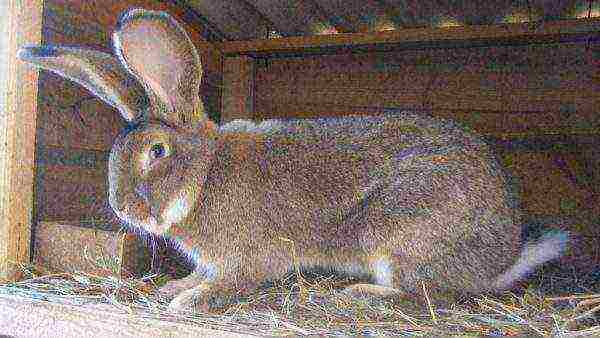
But this breed has its drawbacks. They need larger cages, but are better kept in enclosures. They eat a lot of food. Rabbits are late ripening. They often have difficulty in childbirth. But if you create decent conditions for them, then it is quite possible to breed for income.
New Zealand
They belong to meat.The average weight of these animals is up to 5 kg. Pure white. Compact body with well developed muscles. Small head with erect ears. Developed backbone. The carcass is dense without excess fat.
Rabbits of this breed are fertile and milk-producing. They are ways to feed up to 12 babies. Rabbits grow rapidly and at 3 months can weigh up to 3 kg. Since there is dense wool on the soles of the feet, it is possible to keep it on the net. Calm and balanced.

Ram
They belong to meat. The breed got its name from its long, lop-eared ears. Large breed. Body length up to 70 cm. Weight 7-8 kg. Velvet skin in different shades. Downed, strong body. Excellent taste of meat. Rabbits are late maturing. They bring 9 rabbits each. Calm. Regular ear care is required.
Meat also includes:
- - white giant;
- - gray giant;
- - Californian.

White
A popular representative of the downy breed. Various colors: white, black and blue. The average weight is 4 kg. Body length 55 cm. 7 rabbits are brought. The fluff is combed out from 700 gr to 1000 gr.
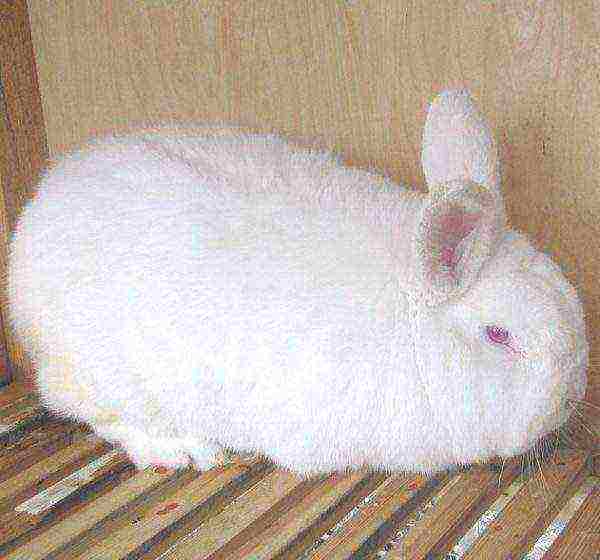
Angora
Body weight 3 kg. The bunny brings up to 6 bunnies. They grow slowly. Contained mostly at home. Require maximum skin care. Cheerful, playful character.
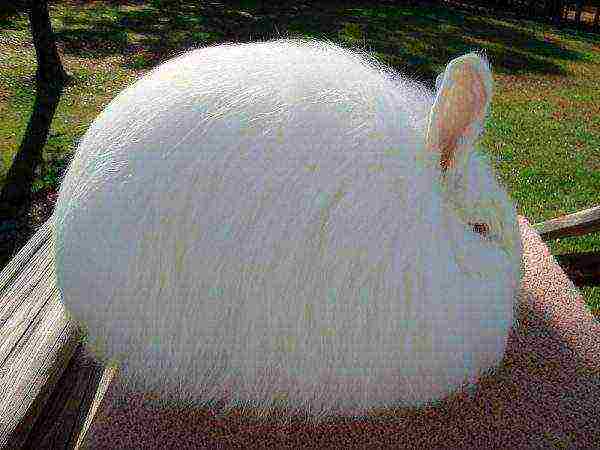
Black-brown
They belong to the meat and skin breed. They have a beautiful skin and tasty, tender meat. Hardy rabbits. The rabbit brings up to 8 young rabbits, which are actively growing.
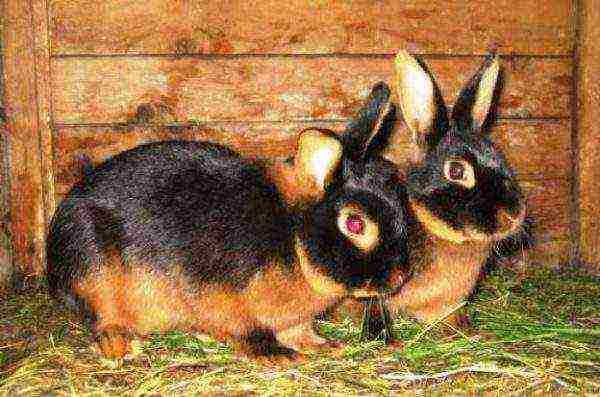
Butterfly
They have an interesting color. On a white background, specks are like the wings of butterflies. Spots of various shades: blue, yellow, black and gray. Highly fertile rabbits. Perfect for keeping in the Russian climate. Beautiful skin and delicious meat.
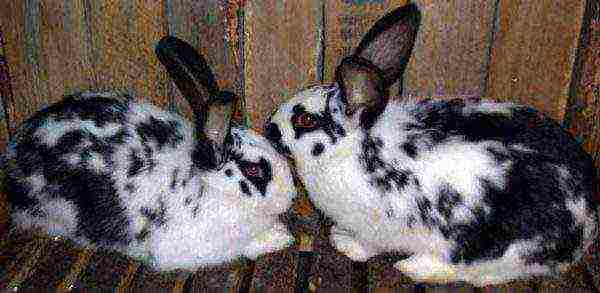
Soviet
First of all, they have a beautiful blue-gray skin. Growing fast. They bring 8 rabbits each. The mass of adults is from 5-8 kg.
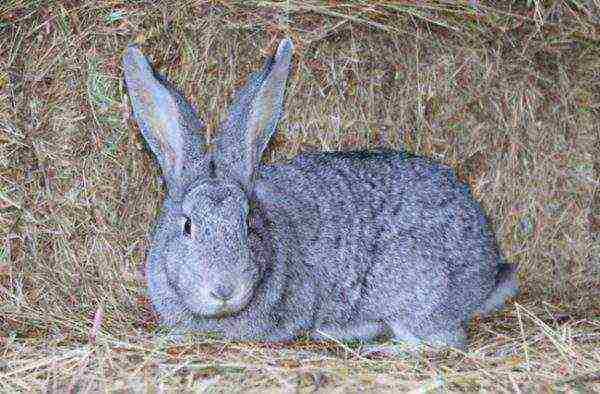
Arrangement of the place of detention
In rabbit breeding, there are several ways of keeping:
- Pitched.
- Cellular.
- Shedovy.
- According to Mikhailov's system.
And now about each method in more detail.
The pit method of keeping is the most ancient. This method is closer to natural conditions, which has its pros and cons. The advantages of this method are:
- arrangement of a pit from available materials;
- when you start several families in it, we get a large, healthy offspring;
- early maturity increases;
- rare pit cleaning;
- getting healthy animals due to their active lifestyle;
- there are no problems with animal health;
- saving space, in a pit 2 * 2 it is possible to keep up to 200 individuals.
For all its advantages, the pit content has its disadvantages:
- infections spread to all animals;
- pit cleaning is a complex process;
- it is better not to breed large breeds in pits with valuable fur;
- closely related relationships, animals become smaller over time;
- catching the animal is difficult.
However, with the right approach to the arrangement of the pit, this method can be used for breeding pets.
Standard pit:
We choose a dry place without a close occurrence of groundwater. A hole of 2 * 2 m is suitable for 200 animals. We dig at least 1.5 m deep. This is due to the fact that the animals dig horizontal burrows and can dig a passage to the surface. To prevent this from happening, reinforce the walls with mesh, brick or slate. One wall remains open. There will be nests in it. To start the minks from the bottom, make a groove 20 cm.
Pour a 20 cm layer of sand at the bottom, and equip a grid or slatted floor on top. Cover with straw or sawdust and clean once a week.
It is advisable to make a roof over the pit. To prevent overheating, do not cover with metal sheets.Be sure to make a pipe for air circulation.
Arrange artificial lighting in the winter. Equip drinkers and feeders in such a way that animals have enough room for everyone. Finally, enclose the area with a fence.
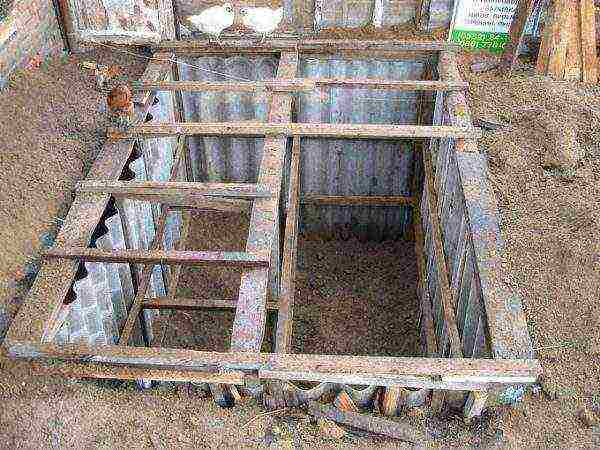
The cage method is the most popular among rabbit breeders. Side and back walls are made of wooden planks. The ceiling, floor and doors are covered with mesh. In cold climates, cages are made portable. During cold weather, they are transferred to sheds or any insulated room.
It is possible to install in several rows on top of each other. There are one-section and two-section. Two-section ones are used for rabbits, where one compartment is nesting, the second is fodder.
Standard sizes of single-section cages:
- length - 110 cm;
- width - 60 cm;
- height - 60 cm.
Two-section:
- length - 150 cm;
- width - 60 cm;
- height - 60 cm.
Fattening juveniles are kept in cages up to 3 m long. Dense planting is not recommended. The fewer animals in the cage, the higher the weight gain.

Content in sheds Is an improved cellular content. The cages are arranged in a row and equipped with devices that facilitate the care of the animals. Sheds are arranged in one, two or three tiers on both sides of the aisle.
Equip pull-out trays for quick cleaning of cages. The manure is transported along the aisle on trolleys or removed mechanically. Automatic drinkers are being arranged. Gradual feeders.
Thus, from several tens to several thousand animals are kept. Shed content in most cases is used by farmers and large farms. Depending on the climate, sheds are arranged under sheds or in closed rooms with ventilation.

According to Mikhailov's system. The system was developed by Academician Mikhailov. This method allows you to raise rabbits in special mini - farms. It is designed for the rearing of rabbits on an industrial scale. It is possible to keep a large livestock in them. At the same time, they are served by three to four people.
According to this method, animals are kept outdoors on rabbit farms. Everything you need is present in the mini farm. It is warm in cold weather, cool in heat. The animals are provided with food and water around the clock.
Animals gain weight quickly and are completely healthy. They are also called Mikhailov's accelerators. Do not confuse - accelerate is not a breed, but a rabbit raised by a special method. An expensive system, because the cost of the cells is high, but if you make them yourself, then the costs are reduced. The use of the system allows you to increase the speed by three times. Next, let's see how to make DIY cages for rabbits drawings according to Mikhailov.
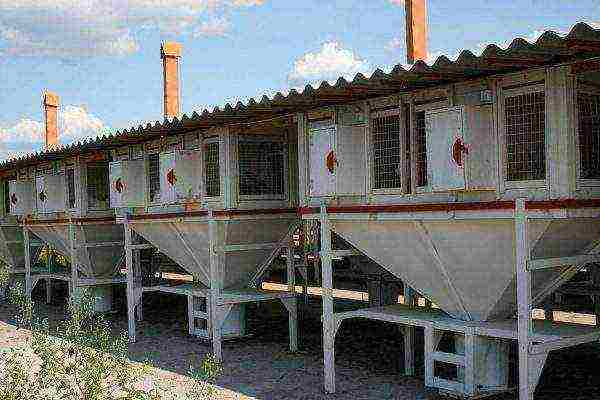
How to make a cage according to Mikhailov's method with your own hands according to a drawing with dimensions?
The farm consists of several compartments. It includes:
- - nesting compartment;
- - for young animals;
- - extractor hood;
- - heating for the nest;
- - feeders;
- - drinkers.

The cage is built in several tiers:
The first tier is a stand. It rests on four racks. The uprights are made of sturdy beams. The supports of the upper tiers are made of beams.
A stand frame is adapted to support the structure. It has compartments for electrical equipment and tool storage. It also has a ladder and a feces barrel. It is better to collect it from a material that does not rust. Below are the drawings of the cage for rabbits with dimensions according to the Mikhailov method.
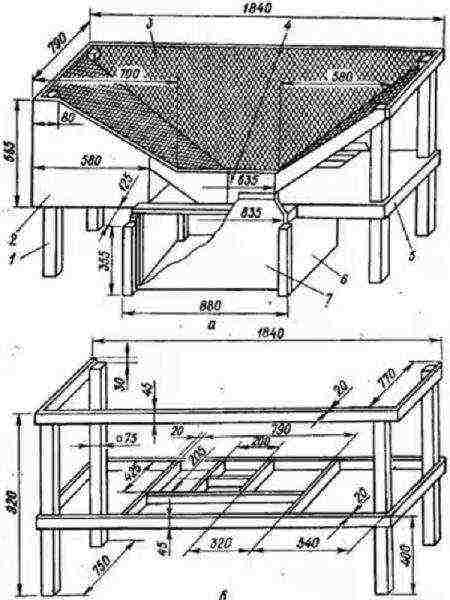
The middle tier is located on the stand. It is designed for animal walking and maternity ward. With the help of racks, the tier rests on a support. The dimensions of the racks are 2 * 10 cm. On the east side, the hole is covered with a net. The grid contains a 250 * 250 mm window. On this tier there is a trap for control and jigging, as well as a shelter.

The farm is divided into several sections. The bunker trough and drinker are located in the walking section. A 20 * 30 cm slit is made from below. It leads to the pitched mines. Tilted 100 mm to the right. This is how it is combined with the lower compartment on the first floor. The deck is tilted at 45 °. Protection from rats is made of metal strips.

At the bottom, slats of 2 * 45 cm are stuffed. Poop falls into the gaps and the cage is always clean.
The design includes a pipe for ventilation. This prevents gases from accumulating inside.
The nesting compartment has a door that can be folded back. When it is open, it creates a table for working with babies. This compartment has a solid floor. It is slightly lower in level. The outer walls are insulated. The manhole is closed by a view from the south side.
Since the mother liquor is made removable, there are gaps on the sides. To prevent animals from entering this hole, they are covered with boards. It is better to make a metal damper that blocks the nest. The door is made of wood.
On the upper tier there are growing rabbits. A separate section is made for the male. She stands for the frame.
The water tank is located between the compartments on the front wall. Moisture enters it automatically from other containers, which are located outside on the wall of the walking compartment. In order for the water to be warm in cold weather, heating with a boiler is provided.
There is a bunker trough next to the drinker. A utilizer has been added to it. When the rabbits rake out the hay, crumbs are poured into it. The crumbs can be reused. The top of the trough is folding. When you need to put in the next portion of feed, it opens.
For hay and root crops, the feeders are located between the floors. The heavy lid pushes the food down.
A complex design, but having built one with your own hands, the rest will be easy to do. After you try it at work, transfer the rest of the animals to such cages. Indeed, in such cages it is easy to work with animals, and they, in turn, feel great.
Let's talk more about organizing a rabbit farm.
Farm organization
No special permission is required for its construction. The main thing is the availability of a plot of land and a ready-made business plan with calculations. It is important that this site is located at some distance from residential buildings, ask the local authorities about this. Moreover, this applies to farms, not a household of 10-20 heads.
Choose a place for a farm on a hill or with a slope. After you have cleared the entire area, it needs to be asphalted or concreted. Also make a water drainage system.
By the way, it is worth remembering that rabbits can get sick. And you need to know the causes of bloating in rabbits, the symptoms of myxomatosis and coccidiosis.
In order to receive about 1000 carcasses of meat per year, the area of the farm will be about 1000 square meters of land. What to place on the site:
- Shed - 3 pieces (360 sq.m.).
- The stern shop must be accessible by car (200 sq. M.).
- Sheds where inventory and building materials are stored (50 sq.m.).
- Slaughterhouse and refrigerators room (50 sq.m.).
- Manure tank (30 sq.m.).
- Passages for the passage of mini tractors.
Sheds
Using sheds saves time on maintenance and building materials. We install two tiers of cells. Make windows 20 * 100 cm on the back walls.
- length 20 m;
- height 2 m 40 cm;
- passage width 1 m 40 cm.
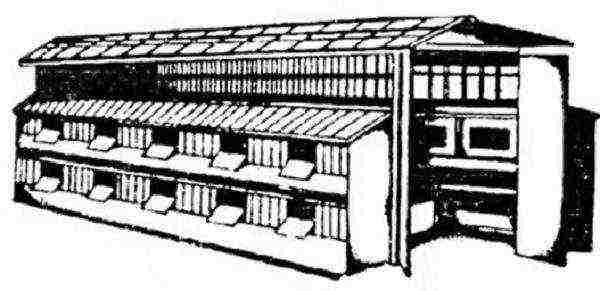
Cells
The cells are according to the sizes given below, then they are divided for males, females and young animals.
- length 1m 30 cm;
- width 70 cm;
- front wall height 55 cm;
- back wall height 40 cm.
The slope of the roof is made for easy manure removal. Make such pallets for all tiers.
When making cages, use a galvanized mesh with a mesh size of 18 * 18, 20 * 20, 16 * 48 mm.
A mesh hay nursery is installed between the cages. Drinkers and feeders are installed under the manger.For females, the cages are divided into nest and feed compartments.
This shed fits 60 cells. During the year, it is possible to grow 400 or more young heads.
Feed shop
On the farm, you will need a feed shop. This room stores compound feed, grain and a grain crusher. You can also put a granulator and prepare compound feed with your own hands.
Separately place a shed for storing tools and building materials.
Slaughterhouse and refrigerators
Mass slaughter is more convenient to do in special rooms. Therefore, put a slaughterhouse on the farm. Better if you attach it to a room with refrigerators. The slaughterhouse must be equipped with a blood drain and an oven. The oven will be required to incinerate waste (feet, heads, entrails, and waste skins). Thus, there is a continuous process: slaughtering, cutting, packing and freezing. Read how to slaughter a rabbit in a separate article.
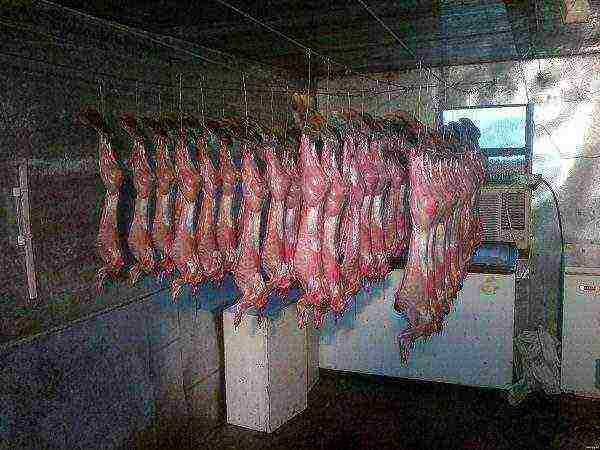
Manure collector
You shouldn't forget about manure either. Set up a manure pit on your farm. It should be located in the farthest corner. As far away from rabbits and slaughter as possible. The pit walls should be concreted. The depth of the pit is not less than 3 m. The length is arbitrary.
Now let's look at the complete rabbit breeding business process.
Since we breed rabbits for meat, then we choose the breed for the meat direction. Not bad, and even successfully bred and pay off such breeds: white giant, gray giant, silver or black-brown, flanders, Soviet chinchilla, Californian, butterfly, ram and there are several more breeds.
With proper care, by 3-4 months the weight of a carcass is from 2-3 kg. Early maturing and prolific breeds. Soviet chinchilla are wonderful mothers. The character is calm and capable of accepting strangers.
Purchase farm animals from reputable farms. If possible, visit the agricultural exhibition, where you can choose a supplier.
When purchased, young animals must be vaccinated against infectious diseases. Since rabbits are stressful animals, in order for their transportation to go without problems, they need to be given antidepressants or to drip vitamin B6 when drinking, which acts as an antidepressant.
How to organize feeding on the farm?
If someone thinks that it is possible to feed rabbits with hay and grass alone, he is deeply mistaken. For success in business, they need a complete feed and without feeding with grain-flour feed nothing will work.
Rabbit diet, daily dose in grams:
Main livestock:
- Meadow grass - 1500;
- Legumes - 1200;
- Branches - 600;
- Beet tops 200;
- Cabbage leaves (should be given with caution) 600;
- Carrots 600;
- Fodder beets 200;
- Sugar beet 600;
- Turnips 400;
- Boiled potatoes 400;
- Raw potatoes 150;
- Silo 300;
- Hay 300;
- Cereal grain 150;
- Legume grains 50;
- Oilseed grain 20;
- Bran 100;
- Oilcakes 100;
- Meat and bone meal 15;
- Salt 2.5;
- Chalk 2.
Try to adhere to these norms. Do not overfeed animals.
To make it easier to navigate how much feed you need per year, see the following figures, kg.
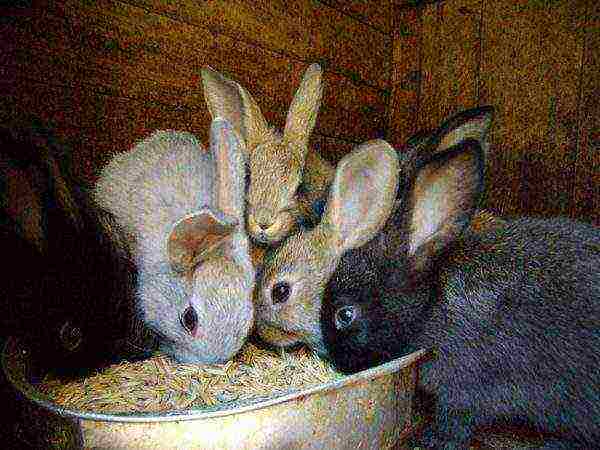
For females and males during the resting period:
- concentrates 3.50;
- hay 1.20;
- root vegetables 3.25;
- green feed 4.50.
Females and males during the breeding period:
- concentrates 4.20;
- hay 1.50;
- root vegetables 3.8;
- green feed 5.6.
Female succumb:
- concentrates 17;
- hay 6;
- root vegetables 16;
- green food 23.
Lactating female:
- concentrates 62;
- hay 21;
- root vegetables 57;
- green food 83.
Young growth 45-120:
- concentrates 10;
- hay 3.20;
- root vegetables 12.
In the morning, the animals are given juicy food and green ones. At lunchtime and in the evening - concentrates.Drinking, fresh water should be available at all times.
Breeding rabbits
Rabbit reproduction is an important process in rabbit breeding. Follow it according to the scheme. In the sheds, the upper tier is occupied by females and one male. Young animals are seated in the rest of the cells.
Each rabbit gives 3 about: in spring, summer and autumn. It turns out about 25 babies. Rabbits sit under the female until two months of age. In total, 300 heads are deposited for fattening. Keep in mind that waste is inevitable for one reason or another. They are freely placed on the rest of the cells.
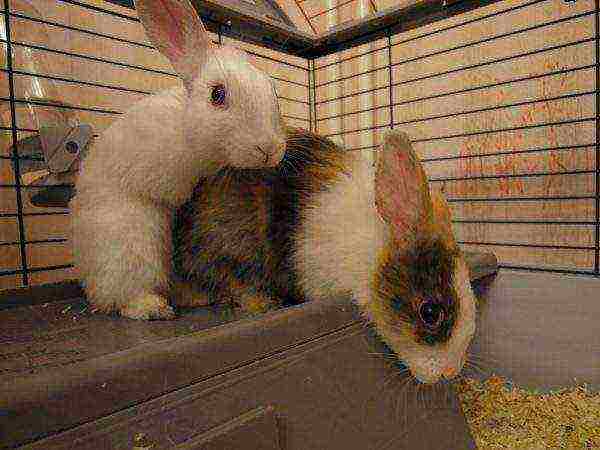
3 sheds of 60 cells, as a result, 3 * 300 = 900 heads per year.
It makes no sense to keep breeding stock for pure breeding. The result is expensive content. It is easier to buy several heads of young stock for livestock repair.
Saving feed
Feeding rabbits with commercial food, as you know, is expensive. It is impossible to grow grain. You cannot reduce the feeding rate. Therefore, it is better to produce compound feed yourself.
For this, a grain crusher and a granulator will be needed. Pellets are readily eaten by rabbits.
Several recipes for granules. Option for everyone:
- oats, wheat 30;
- barley, corn 45;
- wheat bran 12;
- cake 12;
- chalk 0.5;
- salt 0.5.
Option for young animals:
- oats, wheat 40;
- barley, corn 45;
- cake 8;
- meat and bone meal 6;
- fish meal 6;
- chalk 0.5;
- salt 0.5.
Option for everyone:
- oats, wheat 31;
- barley, corn 32;
- wheat bran 15;
- cake 15;
- meat and bone meal 3;
- fish meal 3;
- hydrolytic yeast 2;
- bone meal 1;
- salt 1.
Harvesting hay also brings great savings. But silage and growing root crops are unrealistic. Therefore, it is better to buy them.
Try to mechanize manual labor. Buying a mini tractor will greatly facilitate manual labor. On it you can bring feed to the Swedes, as well as take out manure. Set up an automatic water supply.
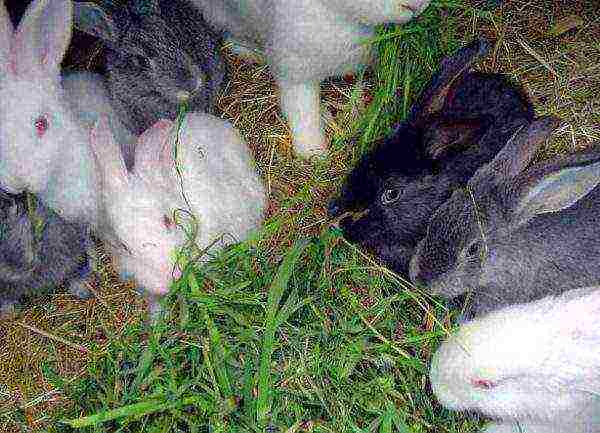
Rabbit conditions and vaccination
To avoid various diseases, rabbits need to be provided with good conditions.
The cages must be clean and dry. If the cages are wooden, it is advisable to whitewash with lime every six months. Before entering the shad, make a square depression and pour lime into it, too, so that those who come pass through this lime. In this way, the shoes will be disinfected.
To avoid mass extinction of livestock from infectious diseases, vaccination is required. At this time, a comprehensive vaccination against VGBK and myxomatosis has been developed. Such a vaccination is given in the spring to adults, and young animals are vaccinated every three months.
Realization of domestic rabbit meat
Of course, everyone is interested in the sale of meat. First, treat and offer rabbit meat to your friends, acquaintances and relatives. If they like it, rest assured that some of the rabbit meat will go off with a bang. Delicious kebabs from rabbit meat and delicious baked rabbit with mushrooms. In this way, your own customer base is created.
What to do next? It's simple: all kinds of ads. It is important that the price is non-cloudy and affordable for people.
Sale of meat from the yard does not require permits. But if you hand over to dealers, then you need a veterinary certificate.
You can try to suggest to restaurants. But since they don't cook rabbit meat in Russian restaurants, they will most likely refuse you. Then you can do so, invite the chef to cook a rabbit dish and give him a couple of them. If that works, you will have a well-established distribution channel. But, then several permits will be required.
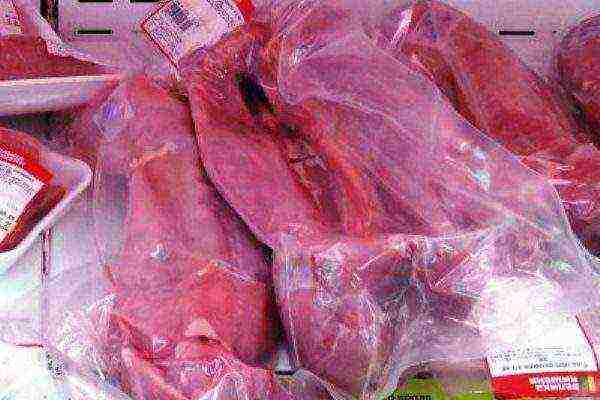
You can open your own retail outlet or offer your goods to shops, wholesalers or supermarkets. But the fact is that 1000 heads per year or 2000 kg of meat is a small volume. Subscribing annually will eat up most of the profits.
To resolve this issue, contact directly the points of sale and solve it individually. Large suppliers to such points deliver their products at extremely low prices.... But they have huge volumes. And you can end up going broke.
Business profitability with a business plan
The amount of the initial investment will be different for everyone. Because the cost of building materials is different in all regions. And then, perhaps you already have, say, a tractor, or some kind of equipment. And someone will start from zero.
The list of necessary for breeding rabbits:
- Building materials:
- galvanized profile;
- galvanized mesh;
- roofing materials;
- lumber.
- Land plot:
- it is better to rent it, it is cheaper.
- Accomplishment:
- storm sewer;
- water drainage;
- asphalt or concrete;
- Construction costs:
- construction team;
- Necessary equipment:
- mini tractor;
- grain crusher;
- granulator;
- refrigerators.
- Rabbits:
- not less than 50 heads.
- Inventory:
- feeders;
- drinkers.
Annual cost of raising a rabbit on a mini farm
The amount of feed consumed per year by one production unit is multiplied by the cost of compound feed. Add to this amount the amount of other expenses: paperwork, fuel, etc. We get the annual amount of expenses for one unit of production.
The farm, which consists of 3 sheds, has 42 production units. That is, there are 14 females in each shed. Now multiply 42 by the sum of the annual expense (let's say 2000 rubles). The annual expense will thus amount to 84,000 rubles. But as you know, there is no such thing as additional costs, so let's add a little to this amount. We get 100,000 rubles.
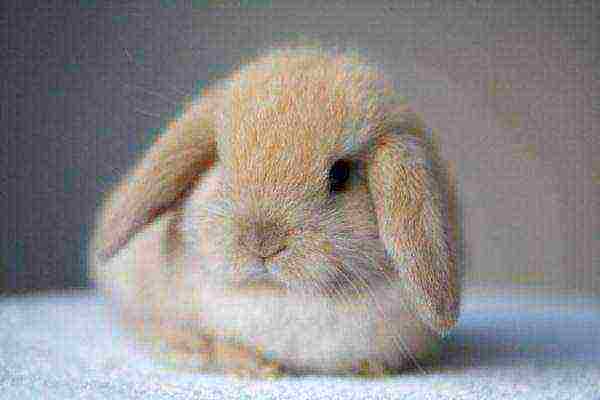
Income calculation
The production unit is 50 kg of meat (25 grown rabbits * 2 kg). For most people, it is not the taste of the product that is important, but its cost, so we put it at about 200 rubles. Now 200 * 50 = 10,000 rubles. It is sourced from one production unit.
Now 10,000 needs to be subtracted from 2,000 and we get a net profit. That is 8,000 rubles. This amount must be multiplied by 42 and you get 336,000 rubles of net profit per year. We divide by 12 months and we get that 30,000 rubles a month. Judge for yourself - a good salary.
You can receive such a salary by devoting only 4-5 hours of time to a mini-farm. Agree it is profitable to keep rabbits and creating a farm from scratch is not so difficult. Moreover, if you want more, you just need to increase the livestock. When the system is on stream, you can think about industrial production.
As you can see, the rabbit breeding business is quite a profitable business. Raising rabbits is fast and all costs are paid off in a year.
